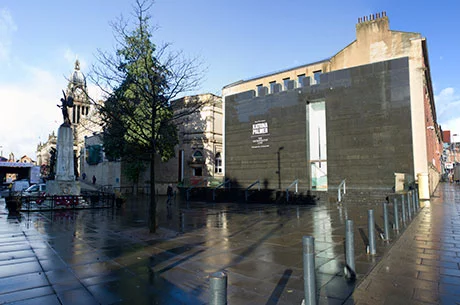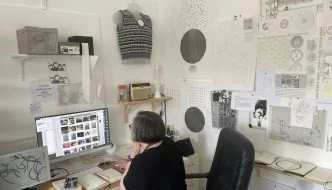Review: The Necropolitan Line at The Henry Moore Institute
February 1, 2016

Photograph credited to David Cotton
‘HALLOA! Below there!’ calls Charles Dickens’ narrator in The Signalman to the troubled title character who has heard ghostly apparitions on the train tracks call those words before. The Signalman is printed in The Line, a fictional newspaper and publication which is to be read in the space, which provides the textual element of an exhibition that The Henry Moore Institute writes ‘[uses] sculpture, sound and the printed page’. Katrina Palmer’s exhibition, The Necropolitan Line, at The Henry Moore Institute creates links between the dead, ghosts and trains, a familiar concept to anyone who has ever visited a fairground or read Agatha Christie. In this space Palmer does away (mostly) with the fictional and directly addresses the truth behind ghostly trains which worked in London to carry the dead.
‘Utilitarian seating’, and a stark, white room confront visitors on first entry to a room which is dimly lit by two illuminated images of unknown train station signalling poles. This is the first of two ‘waiting rooms’ which are connected by a railway platform, cutting through the gallery space. This division between the two waiting rooms provides the disconnect that Palmer hopes to evoke between the living and the dead. The London Necropolis Railway, which began operating in 1850, provided a service between overpopulated and cholera-plagued London and Brookwood Cemetery (also known as the London Necropolis), a giant burial ground in Surrey built to accommodate the large number of dead which London’s graveyards could no longer house. The Line’s front page introduces readers to Cross Bones, an unconsecrated medieval cemetery situated in The Borough, London, where thousands of prostitutes, their children and paupers were buried.
The space evokes the feeling of travelling between the overcrowded Cross Bones cemetery, which closed in 1853 for being ‘completely overcharged with dead’, and the new London Necropolis via the railway platform between the spaces, which represents the London Necropolis Railway. In the second waiting room there is, again, seating, another illuminated image and a stack of Palmer’s accompanying text, The Line. Echoing the space, the newspaper also takes the reader through a journey, this time a narrative one, which begins with Cross Bones and ends with the Necropolis through a montage of fictional and factual articles and stories relating to human experiences. Then, there is the use of sound, which works as Palmer’s own voice taking the role of a platform announcer, echoing through the two waiting rooms and platform, reciting sentences from articles in The Line, and declaring such dry anecdotes as ‘we’re sorry for being sorry’. It is this which attaches the voice to a small article in The Line, which is darkly, yet faintly humorously, titled ‘Platform Announcer Exposed as Disembodied Automation’.
The effect of reading Palmer’s intelligent articles, whilst sitting upon a dimly lit platform, waiting for a train that will never come and hearing her recite disconnected passages from Dickens’ The Signalman is a fascinating experience. It’s an experience that attracted both a group of seniors, and a huddle of college kids to The Henry Moore Institute on the rainy Tuesday morning that I visited to sit in quiet contemplation on a fake railway platform in the middle of a gallery. It’s this coming together of people that allows The Necropolitan Line, as The Henry Moore Institute’s pamphlet states, to perfectly ‘address the enduring sculptural concerns of memorial, objects, material and human encounters’, themes which are so important to us all.
Filed under: Art & Photography
Tagged with: art, exhibition, Henry Moore Institute, Katrina Palmer, sculpture, yorkshire



Comments